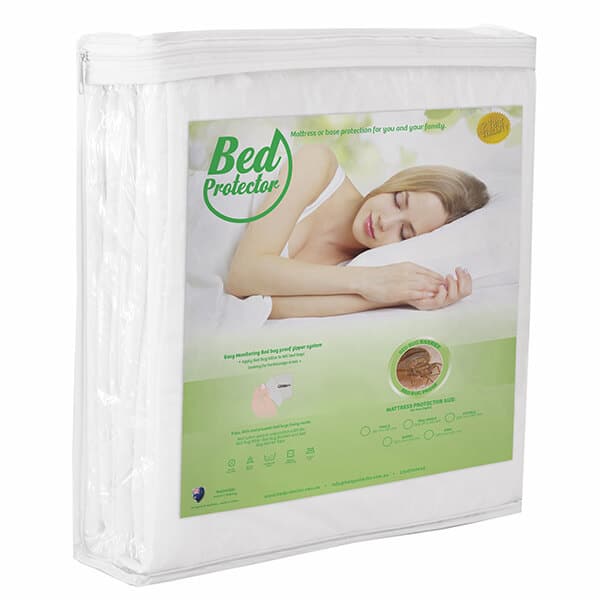
In the article
Last Updated on 18/04/2025 by Tony Abrahams
This guide will walk you through everything you need to know—what works, what doesn’t, what to avoid, and how to stay warm and bite-free at the same time.
Let’s dive in.
🔥 Can You Use Bed Bug Covers and Electric Blankets?
In short? Yes—but it’s not always straightforward.
Bed bug mattress encasements are made with specific materials designed to trap bed bugs inside (so they eventually die off) and stop any new ones from reaching your mattress. They’re typically made from tightly-woven polyester, polyurethane, or similar synthetic blends that create a sealed barrier. Great for bugs—not always ideal for heat.
Now, add an electric blanket into the mix. You’re generating additional heat and layering it over a potentially heat-sensitive cover. That’s where things can get tricky.
Some covers can melt, warp, or break down when exposed to regular, direct heat—especially if they’re cheap or made with vinyl.
Others might cause the electric blanket to overheat, especially if the cover traps heat and doesn’t allow for proper airflow.
And then there’s the safety issue: electric blankets that aren’t meant to be used over synthetic materials could become a fire hazard if misused.
If you want to use both, here’s the golden rule: check the manufacturer’s label. Look for heat-resistant or “safe for use with electric blankets” language. If it’s not clearly stated, it’s better to be cautious.
In a nutshell: yes, you can combine them—but don’t just wing it. Be intentional with your product choices.

Bed bug covers and electric blanket
🐛 Will Heat from an Electric Blanket Kill Bed Bugs or Make It Worse?
Ah yes, the age-old myth: “If I turn my electric blanket up high enough, I’ll cook the bed bugs alive.” If only it were that simple.
While it’s true that heat kills bed bugs, it has to be very specific heat. We’re talking 48°C (118°F) or higher, sustained for 90 minutes or more. That kind of heat usually comes from professional-grade steamers or whole-room heat treatments—not your average electric blanket.
Most electric blankets max out at around 30–43°C (86–110°F), depending on the brand and setting. That’s to keep you comfortable, not to kill anything hiding deep in your mattress seams.
In fact, here’s the bad news: bed bugs love warmth. They’re drawn to body heat, carbon dioxide, and movement. An electric blanket might actually signal to them, “Dinner is served!”
So instead of killing them off, your electric blanket could be turning your bed into the ultimate five-star buffet.
That’s why it’s crucial to use long-term bed bug barriers and traps in conjunction with encasements—so even if the heat attracts them, they’re intercepted before they reach you.
🛏️ What’s the Best Bed Bug Cover That Works With an Electric Blanket?
Here’s where the rubber meets the road—or in this case, where the electric coils meet the mattress cover.
If you’re committed to staying warm and keeping bed bugs at bay, you’ll need a cover that can handle both jobs. Not all mattress encasements are built to tolerate added heat, so don’t just grab the cheapest option on the shelf.
Look for the following features:
✅ Heat-resistant materials: Polyester blends are your best bet. Steer clear of vinyl or anything that feels stiff or plasticky.
✅ Breathable fabric: You want something that allows airflow to prevent sweating and moisture build-up under the electric blanket.
✅ Secure zippers with bug-proof seals: A good encasement will zip tight with reinforced stitching and internal flaps to stop bugs from sneaking in or out.
✅ Quiet material: Trust me—you don’t want a crinkly, plastic-feeling cover under your electric blanket. It’ll sound like a bag of chips every time you roll over.
Also, make sure you get full encasement covers for both the mattress and the ensemble base. That’s the only way to completely trap existing bed bugs and block new ones.
Pro tip: Combine your mattress cover with bed leg traps and Diatomaceous Earth (DE) powder around the base. This creates a powerful, non-toxic perimeter that stops bed bugs in their tracks—literally.

Bed Bug Covers and Electric Blankets
⚠️ Will a Bed Bug Cover and Electric Blanket Combo Ruin My Mattress or Void the Warranty?
This is one of those things most people don’t think about until it’s too late.
Mattress warranties are notoriously picky. If your mattress gets stained, overheated, or shows signs of improper product use—like moisture damage from trapped heat—you could find yourself out of pocket fast. Same goes for electric blankets.
Here’s what to be aware of:
🔥 Overheating risk: Heat can get trapped between your body, the blanket, and the synthetic cover—especially if your mattress is memory foam or latex. That trapped heat can degrade materials over time.
💧 Moisture build-up: Synthetic covers don’t always breathe well. Combine that with sweat and heat, and you could end up with mildew or mould inside your mattress. Not a great vibe.
📜 Voided warranties: Many manufacturers explicitly state that certain combinations of products (like electric blankets with plastic-backed covers) void the warranty—check the fine print!
So if you’re investing in premium bedding, it pays to use compatible, high-quality gear—and when in doubt, call the brand and ask.
❄️ Can I Stay Warm at Night During a Bed Bug Infestation?
Absolutely! Just because you’re battling bed bugs doesn’t mean you have to freeze.
In fact, one of the worst parts about treating an infestation is the discomfort—between the bites, the paranoia, and the temperature drops, your sleep suffers. So here are some safe ways to stay warm without compromising your bed bug treatment:
🧦 Layer up smart: Wool socks, flannel pyjamas, and thermals go a long way without adding heat that might cause moisture issues.
🔌 Use a heated throw instead of a full electric blanket—it provides targeted warmth and lessens the risk of overheating.
🌬️ Don’t tuck the electric blanket under layers of bedding or plastic covers. That prevents airflow and can create hotspots.
🛏️ Set your bed up properly: Keep it at least 30cm away from the walls, install bed leg traps, and dust around the base with Diatomaceous Earth. That way, if bed bugs are lured in by your body heat, they’re intercepted and killed before they reach your skin.
When done right, your bedroom can still be a safe, warm place—even during a bed bug infestation. The key is combining comfort with clever bed bug control methods.

🧠 Final Thoughts: Can Bed Bug Covers and Electric Blankets Coexist?
Yes, they can. But only if you’re strategic about it.
Here’s what we’ve learned:
🔥 Electric blankets won’t kill bed bugs. They may even attract them if you’re not protected.
🛏️ Not all covers are created equal. Look for heat-resistant, breathable options with reinforced seams.
⚠️ Don’t risk damaging your mattress or voiding your warranty. Know your gear and how it works together.
❄️ You can stay warm during a bed bug infestation. Just be smart about your setup.
And remember, the ultimate goal is long-term protection. That means using an integrated system—bed bug mattress covers, ensemble base covers, bed leg traps, and Diatomaceous Earth powder—to kill and block bed bugs from every angle.
Want to finally stop bed bugs for good and still get a good night’s sleep?
👉 [Shop our Complete Bed Bug Isolation Kit] – Works with your electric blanket and provides years of protection
Don’t wait until the infestation spreads—protect your bed once and sleep better tonight.
Frequently Asked Questions: Bed Bug Covers and Electric Blankets
- ❓Can I put an electric blanket on top of a bed bug cover?
Yes, you can—but only if the bed bug cover is heat-resistant and breathable. Most high-quality bed bug encasements are designed to handle regular bedding use, but cheaper vinyl or plastic covers can overheat, melt, or degrade when exposed to electric blanket heat. Always check the care label or product description before combining the two. If the cover doesn’t specify heat resistance, it’s best to avoid using an electric blanket directly on top of it. - ❓Will using an electric blanket make my bed bug problem worse?
Unfortunately, yes—it can. Bed bugs are drawn to warmth and carbon dioxide, which is why they typically bite at night. Electric blankets create a warm environment that can actually attract bed bugs to your bed faster, especially if you’re not using traps or powder barriers. The heat from an electric blanket isn’t high enough to kill them, so without protection, you could be giving them easier access to a blood meal. - ❓Is it safe to use a heated blanket if I’m treating my bed for bed bugs?
Yes, but be careful how you do it. As long as you’ve properly set up your bed bug protection system—using a certified mattress cover, ensemble base cover, bed bug steamer, bed leg traps, and Diatomaceous Earth—you can safely use a heated blanket. Just don’t trap heat and moisture by tucking everything in too tightly, and avoid layering multiple synthetic materials that could cause overheating. If in doubt, consider using a heated throw instead of a full electric blanket to reduce the risk.
Are You Looking for an Organic DIY Treatment?
Watch Our DIY Treatment Video For An Ensemble Bed
Watch Our DIY Treatment Video For A Bed with Slats
If you have enjoyed our blog, Bed Bug Covers and Electric Blankets, then you might like to read about Bed Bug Bites in Australia: How to Find, Treat and Prevent Bed Bugs Fast



Leave a Reply